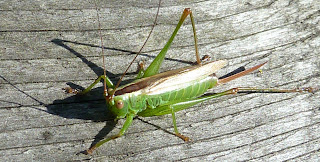What a lovely sunny day - ideal for a trip to the coast, so off I went to Dungeness with my usual Wednesday companions - minus one - Paul having something more important to do.
 |
| The Old Lighthouse |
We usually scan the patch when we arrive, but as migrants could be in the offing we decided to try the area around the observatory and trapping area (that's trapping for bird ringing of course). The first thing to notice was the huge number of starling that are gathering at the moment, getting ready for their autumn movement, they were joined by linnet as both species fed on the ground near the rough track which we were following. Near the buildings house sparrow were numerous.
 |
| The Beach |
Crow, magpie, robin and dunnock were also found in and around the gorse and bramble bushes. As we neared the observatory there were several beautifully marked meadow pipit in their clean plumage and four wheatear - it was good to be able to watch these digging into the soil with their beaks and then hunting for tasty morsels. Over the lighthouse garden swallow were feeding and herring gull called over the power station.
After a short stop for refreshment at the cafe we moved on to the beach to try for the patch. The sight that met us was one of complete calm sea with a sea fog, the weather had encouraged lots of anglers onto the beach but there were few birds to be seen.
As we scanned, Sally spotted a couple of turnstone working their way along the shingle. There were several common terns feeding on the patch but very little else. A string of unidentifiable ducks flew across the bay towards Rye, but we did identify greater black-backed gull and cormorant.
 |
| Spotted Flycatcher |
It was now time to move onto the RSPB reserve. Here the bird numbers increased, along the track off the main road we saw marsh harrier, sparrowhawk and mute swan, and as we walked from the visitor centre we added coot, tufted duck, great crested grebe, lapwing, mallard, pochard, little egret and two grey plover.
Near the Christmas Dell Hide we noticed a photographer moving in on a bird in a nearby bush with his camera poised. This was a spotted flycatcher. Unfortunately the photographer moved a step too close and the bird flew off. We stood and waited after he had left and sure enough the bird returned to its favoured perch. Telescopes gave us great views and as others came along the path we shared 'scopes and views. In the same small tree we saw chiff chaff and in the bushes behind blackcap. Cetti's was heard several times along this stretch of the reserve.
 |
| Stonechat |
Sally spotted a small bird on a fence post which turned out to be a stonechat. Once again, telescopes enabled us to have good views, and our small fan club gathered once again to share the sight.
On the pool at Denge Marsh there were shoveler, grey heron, large numbers of greylag geese, black-headed gull, more great-crested grebe, coot, lapwing, little egret.
As we left the reserve, we stopped at the wardens house and looked for tree sparrow, which have eluded us at this site all year. Luckily today we had good views as they flew between the feeders and trees.
At the Hanson hide we added gadwall, wigeon, and knot - the latter found by Malcolm.
 |
| Small Copper |
The day was not just about birds, we also saw clouded yellow, small copper and small white butterfly, and thanks to Irene's newly syringed ears found two great green bush-crickets.
 |
| Great Green Bush-Cricket |
Now I could tell you what we should have seen - buff-breasted sandpiper, great white egret, whinchat, merlin, the list goes on. Good job we're not into lists!











































